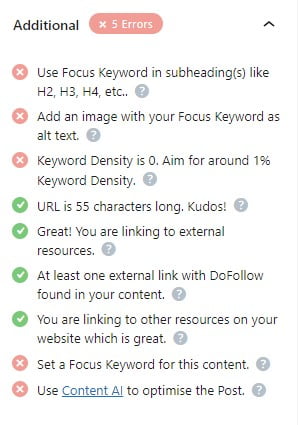Ever found an excellent blog post on page 10 of Google?
Probably not, right? If you’re like most people, you don’t scroll past the first page. You might not even scroll past the first spot.
The first five spots on Google get 67.6% of all clicks. That’s why it’s crucial to write content that ranks well. Otherwise, no one will read it. And you definitely won’t generate any new leads from it.
So, what is SEO writing? And how do you become an expert SEO copywriter? Here’s everything you need to know:

What Is SEO Writing?
SEO writing involves a lot of moving parts; there’s keyword research, heading structure, optimizing images, and more. Basically, it’s when you write content in a way that search engines can easily understand. Optimize your content for search engines, and you’ll see your rankings skyrocket as a result.
Why Is SEO Writing Important?
Given all the time it takes to build a website or write a blog post, you want your efforts to be worthwhile.
You don’t just want to write excellent content. You want to write content that ranks—content that puts your website on the first page of Google. Afterall, it's part of a balanced approach to SEO.
How do you do it?
I’m glad you asked. I’ve put together 15 tips that will help you write content that ranks better.
Let’s get into it:
- Start With Keyword Research
You could write the best blog post in the world—but if people aren’t searching for it, they won’t read it, and you certainly won’t rank for it.
That’s why you need to start every blog post with one crucial thing: Keyword research.
In general, there are two types of keywords you can focus on:
- Target keywords. These are the exact-match phrases that get high search volume.
- Long-tail keywords. Longer phrases or variations of your target keywords. They increase your relevancy for your focus keyword.
So, how do you find out what your customers are looking for? Here are a few SEO tools you can use to do that:
Ahrefs
The Ahrefs Keyword Explorer tool has everything you need to get started with keyword research.
Start by typing in any phrase or topic that’s relevant to your industry, and hit enter. Then, expand the “Keyword ideas” column.
Now, check out all the data you have to work with. At a glance, you can see what’s popular and relevant to your readers. From this list, you can jot down the keywords you want to rank for.
Looking for more info? Read my full review of Ahrefs here!
If you aren’t sure how many times to include keywords in your content, don’t worry—I’ll come back to that later.
Google Keyword Planner
The great thing about this tool is that it’s free (as long as you have a Google Ads account). Once you log in, type in your target keyword.
Then, you can see the average monthly searches for each term. Sort results by “low” or “high” volume, depending on how competitive you want the keywords to be.
These tools give you plenty of ideas. But you might not know which keywords to focus on. Consider these factors:
- Search intent. When people look up this keyword, would they be interested in the products or services you offer? Make sure to focus on your target audience.
- Competitors. Check out who’s currently ranking for that keyword. How challenging will it be to outrank them?
- Search volume. High-traffic keywords get all the glory, but they’re also notoriously hard to rank for. Find the sweet spot between high and low traffic.
- Write for Humans, Not Search Engines
Remember: Your customers aren’t looking for “search engine optimized” content. They’re looking for good content.
You want your content to be easily digestible and concise. A few ways to do that include:
- Creating a buyer persona. What motivates your customers? What scares them? How can they benefit from your products? What are their pain points? By understanding your customer, you can speak to them directly. This helps your content connect with readers.
- Organizing your content. Despite all the effort you put into writing it, most people will skim your content. Don’t take it personally—use it to your advantage. Break up long sections into bite-sized chunks. Use bold headings so people can skip to the content they’re searching for.
- Keeping things interesting. When you’re writing a blog post, try to do more than answer the question or offer information—make it unique! Keep your readers captivated by putting your personality into the piece.
As important as the technical SEO stuff is, you can’t overlook the user experience. That’s because when you provide a great user experience, you also improve the quality of your content; in turn, that helps your SEO.
Even if you rank #1 for your target keyword, you won’t convert customers if your landing page reads like a robot wrote it. Keep your reader in mind whenever you’re writing content.
Resist the urge to keyword stuff
Let’s say you’re going after a highly-competitive keyword. Your first instinct might be to use it throughout the post. But be careful not to overuse it: Google may penalize your rankings for it. Keyword stuffing isn’t helpful for search engines or your readers.
SEO isn’t about how many times you use the keyword—it’s more about where you use it.
- Optimize Heading Structure
How do search engines understand your content? One thing search engine crawlers look at is the heading structure of your page. Make your content easy to understand by using a consistent heading structure.
For example, use an H1 for the title, H2s for subheadings, and H3s for sub sub headings. Using a consistent hierarchy gives your information a logical flow.
Headings are a great place to insert a target keyword or two, especially the H1.
If you’re targeting the keyword “house painter”, you could write headings like, “How much will a house painter cost?” or “Why should I hire a house painter?” This helps increase your chances of ranking for that keyword.

- Write Unique Content
Plagiarism and duplicate content: Two big no-nos in the SEO world. If you want to rank, your content has to be unique.
Not sure if your content is unique enough? Try Copyscape; you can paste your text into the tool, and it will check how original your content is. If you aren’t happy with the score, do some fine-tweaking to make it more unique.
- Answer Questions People Ask
Keyword research is one part of the equation. The other is turning those keywords into topics people are searching for.
So…what are people asking about? Here’s a tool you can use to find out:
Use AnswerThePublic
AnswerThePublic turns your keyword into dozens of topics; it answers the who, what, when, where, and why. For instance, if you type “House painter” into the search bar, you’ll see results like “Do house painters need insurance?” and “Is house painting tax-deductible?”.
Read my full review of AnswerThePublic here.

- Optimize Page Title Tags
A page title is your chance to make a winning first impression—to readers and to search engines. The title tag is what appears on search results in blue text.
To write a title tag that gets clicks, keep it short; ideally, no more than 60 characters; this will prevent it from getting cut off.
Next, fit your focus keyword naturally in the title.
Now, entice readers to click on it. You can go about this in a few ways. A popular approach is to add a number, like “5 Reasons To Hire a House Painter”. Or, try to add an emotional word to the title, one that intrigues readers, like “How a House Painter can Make Your Exterior Amazing”.
Finally, make sure your heading is different from others on the search engine results pages (SERPs). This helps you stand out from your competitors.
- Optimize Page Meta Description
A meta description appears below your title tag in SERPs. It’s a succinct, 155-160 character description of your page content. How do you optimize it? Follow these tips:
- Include your focus keyword. Whenever a user searches for that keyword, any instances of it on the SERPs will be bolded—including in your meta description. This helps draw more attention to your site.
- Don’t make it too long. Try to keep your description under 160 characters; otherwise, it will be cut off.
- Make it interesting. Catch eyes and captivate your readers with a compelling meta description. This is your chance to pitch your content and get more clicks.
- Optimize Content for Schema
Even after you’ve optimized your page title and meta description, you’re looking for more ways to stand out in search engines.
Rich snippets can help with that; they use structured data to add more information to search results. They help search engines understand more about your page and look more interesting to users.
There are plenty of rich snippets you can add. Check out Schema.org to access all kinds of schema markups. But which ones will help your SEO?
Take a look at what the top-ranking pages are doing to find out. For example, let’s say you're developing content for a keyword like “Top 5 House Painting Techniques”.
In the SERPs, you see an unordered list rich snippet. Based on that, you know it would be smart to include an unordered list in your content.
If you don't have a list, there’s a big chance you won't capture that rich snippet. Choose schema markup that will help you stand out in search results.
- Cover the Topic in Depth
SEO content writing can be research-heavy. To be a successful SEO writer, you need to offer something that no other competitor does. Even if you’re covering the same topic as other blogs, give your readers something that other websites don’t.
Not sure how long to make your SEO content? It depends on the topic you’re covering. Take a look at the blog posts written about similar topics. How long are they? If you want to rank above them, you need to write content that’s similar in length (or longer).
When you’re writing blog posts that are 1,000+ words, keep the user experience in mind. Long blocks of text will cause them to lose interest. Keep their attention by using lots of subheadings, bullet points, and images or videos.
Focus on writing high-quality content that’s accurate, comprehensive, and engaging.
- If You Need To Link out, Link To High-Authority Websites
Even after optimizing content with the latest SEO techniques, you still aren’t on the first page. What gives? You might need to boost your authority by adding external links.
Whenever you cite a statistic, a research paper, or an intriguing blog post, add a link! This lets your readers explore the topic further if they’re interested in it. It also shows search engines that you’ve done your research.
With all the misinformation floating around these days, prove that you aren’t pulling information out of thin air by using outbound links.
- Consider Internal Linking

I’ve just covered why you need to link to outside sources. But it’s also important to add internal links—by that, I mean links back to your own site.
Internal links are a big part of SEO writing because they…
- Keep readers on your website by pointing them to other pages.
- Help search engines crawl and index other pages.
- And show that your blog post is relevant to other related pages,
Add a few internal links to any blog post you write. Depending on the topic, you might link to a product/service page, your home page, or a contact form. A cool tool that can help you with internal linking is the WordPress plugin called Link Whispser. Read my full review of Link Whisper here.
- Use Proper Anchor Text
Whether you’re adding internal or external links, you don’t want to paste the entire URL into the content. Wrap it up neatly in anchor text instead!
Anchor text is the blue text that, when clicked upon, takes the user to another page. Make sure the anchor text accurately describes the content you’re linking to.
A phrase like “click here” or “see this” won’t tell search engines much about your link. Keep it short but informative, too. If it sounds natural, try to include a focus keyword in the anchor text for any internal links.
- Add Optimized Images and Videos
No matter how compelling or optimized your SEO writing is, nothing makes people click away faster than a slow-loading web page. Search engine crawlers don’t like it, either; improve your page speed, and you’ll see your rankings improve.
Bloated images tend to slow down your website. Here’s the good news: Optimizing them is easy.
To optimize an image, the first thing you need to do is compress it. A lot.
There are a ton of free tools online that you can use, including TinyPNG. Of course, you don’t want to sacrifice too much quality. Aim for a file size under 250kb.
Next, add alt text. This is a short description of the image used for accessibility purposes. Alt text also helps search engines understand your images.
You can try to insert a keyword into the description, but only if it makes sense for the image. Once you’ve written it, rename the file using the same title.
Adding videos breaks up the text on your page. It adds color and interactivity to an ordinary blog post. Embed a video into your content whenever you see fit. Bonus points if it’s your own YouTube video.
- Build out an Author Profile, so You Become an Authority
Ready to make your name as an SEO copywriter? You need an author bio that proves your credibility.
Think of it this way: Would you be more willing to trust an anonymous author? Or an SEO copywriter with dozens of articles under their belt?
How do you demonstrate your authority? Start posting your blogs using an author profile. With each post you publish, add an author name and bio. Try to keep the posts under the same name; the more publications you have, the more credible you become.
- Stay up to Date
You might wonder why everyone has a different rulebook for search engine optimization. Partly, it’s because SEO changes whenever search engine algorithms update.

Your SEO content writing strategy needs to update with it. Your work isn’t done once you hit “Publish”. Wait a few weeks, and see how the page ranks. If it needs a boost, go back in and tweak it. You may need to add different keywords, more content, or simply update the information.
Lastly, be sure to keep your eye on any search engine algorithm updates. If you want to rise above the competition, you need to keep your finger on the pulse.
Master SEO Content Writing
SEO content writing doesn’t have to be a guessing game. With this guide, you can see through the shroud of mystery. And if you don’t get it right the first time? No problem; you can always go back and edit your content.
Now, you have all the tools you need to write high-quality content that will do well with readers and search engines alike. What are you waiting for? Start writing! As always, thanks for learning SEO from SerpFocus.



Leave a Reply
You must be logged in to post a comment.